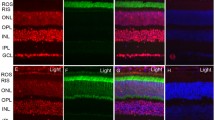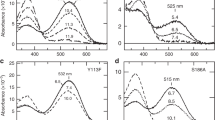Summary
Inositol 1,4,5-trisphosphate (InsP3) is rapidly formed in squid photoreceptors in response to light, where it is converted sequenctially into inositol bisphosphate (InsP2) and inositol monophosphate (InsP1). All of the InsP3 appears to be degraded to inositol 1,4-bisphosphate via an InsP3-phosphatase, which is characterized in this study. The enzyme is water-soluble and present in the light-transducing distal segments of squid photoreceptors. It has a Km of 50 μM for InsP3, requires Mg++ for its activity, is maximally active at neutral pH, specifically hydrolyses the 5-phosphate and is inhibited by 2,3-diphosphoglycerate. In these respects, InsP3-phosphatase of squid is very similar to the enzymes of other cells. Since no InsP4 or more highly phosphorylated inositols are found in squid photoreceptors, the InsP3-phosphatase may be important in the regulation of InsP3 concentration within these cells.
Similar content being viewed by others
Abbreviations
- InsP 1 , InsP 2 , InsP 3 , InsP 4 , InsP 6 :
-
inositol monobis-, tris-, tetrakis-, hexakisphosphate, respectively
- 2,3-DPG :
-
2,3-diphosphoglycerate
- EDTA :
-
ethylene diamine tetraacetic acid
- DTT :
-
dithiothreitol
- Hepes :
-
4-(2-hydroxyethyl)-1-piperazineethanesulfonic acid
- PMSF :
-
phenylmethylsulfonyl fluoride
References
Batty IR, Nahorski SR, and Irvine RF (1985) Rapid formation of inositol 1,3,4,5-tetrakisphosphate following muscarinic receptor stimulation of rat cerebral cortical slices. Bioch J 232:211–215
Berridge MJ (1987) Inositol trisphosphate and diacylglycerol: two interacting second messengers. A Rev Biochem 56:159–193
Berridge MJ, Irvine RF (1989) Inositol phosphates and cell signalling. Nature 341:197–205
Biden TJ, Wolheim CB (1986) Ca++ regulates the inositol tris/tetrakisphosphate pathway in intact and broken preparations of insulin-secreting RINm5F cells. J Biol Chem 261:11931–11934
Brown JE, Watkins DC, Malbon CC (1987) Light-induced change of inositol phosphates in squid Loligo pealeii retina. Biochem J 247:293–297
Brown JE, Rubin LJ (1984) A direct demonstration that inositoltrisphosphate induces an increase in intracellular calcium in Limulus photoreceptors. Biochem Biophys Res Comm 125:1137–1142
Brown JE, Rubin LJ, Ghalayini AJ, Tarver AL, Irvine RF, Berridge MJ, Anderson RE (1984) myo-Inositol polyphosphate may be a messenger for visual excitation in Limulus photoreceptors. Nature (London) 311:160–162
Connelly TM, Bansal VS, Bross TE, Irvine RF, Majerus PM (1987) The metabolism of tris- and tetraphosphates of inositol by 5-phosphomonoesterase and 3-kinase enzymes. J Biol Chem 262:2146–2149
Connelly TM, Bross TE, Majerus PW (1985) Isolation of a phosphomonoesterase from human platelets that specifically hydrolyses the 5-phosphate of inositol 1,4,5-trisphosphate. J Biol Chem 260:7868–7874
Cohen AI (1973) An ultrastructural analysis of the photoreceptors of the squid and their synaptic connections 1. Photoreceptive and non-synaptic regions of the retina. J Comp Neur 147:351–378
Dangelmaier CA, Daniel JL, Smith JB (1986) Determination of basal and stimulated levels of inositol trisphosphate in 32P-orthophosphate-labeled platelets. Anal Bioch 154:414–419
Downes CP, Mussat MC, Michell RH (1982) The inositol trisphosphate monoesterase of the human erythrocyte membrane. Biochem J 203:169–177
Fein A, Payne R, Corson DW, Berridge MJ, Irvine RF (1984) Photoreceptor excitation and adaptation by inositol 1,4,5 trisphosphate. Nature (London) 311:157–160
Hagins WA (1965) Electrical signs of information flow in photoreceptors. Cold Spring Harbor Symposia on Quantitative Biology 30:403–418
Hansen CA, Mah S, Williamson JR (1986) Formation and metabolism of inositol 1,3,4,5-tetrakisphosphate in liver. J Biol Chem 261:8100–8103
Irvine RF, Moor RM (1986) Microinjection of inositol 1,3,4,5-tetrakisphosphate activates sea urchin eggs by a mechanism dependent on external calcium. Biochem J 240:917–920
Payne R, Corson DW, Fein A (1986) Excitation and adaptation of Limulus ventral photoreceptors by inositol 1,4,5 trisphosphate result from a rise in intracellular calcium. J Gen Physiol 88:127–142
Payne R, Walz B, Levy S, Fein A (1988) The localization of calcium release of inositol trisphosphate in Limulus photoreceptors and its control by negative feedback. Phil Trans R Soc Lond B 320:359–379
Polokoff MA, Bencen GH, Vacca JP, deSolms SJ, Young SD, Huff JR (1988) Metabolism of synthetic inositol trisphosphate analogs. J Biol Chem 263:11922–11927
Rittenhouse SE, Sasson JP (1986) Mass changes in myo-inositol trisphosphate in human platelets stimulated by thrombin: inhibitory effects of phorbol ester. J Biol Chem 260:8657–8660
Storey DJ, Shears SB, Kirk CJ, Michell RH (1984) Stepwise enzymatic dephosphorylation of inositol 1,4,5-trisphosphate to inositol in liver. Nature 312:374–376
Szuts EZ, Wood SF, Reid MS, Fein A (1986) Light stimulates the rapid formation of inositol trisphosphate in squid retinas. Biochem J 240:929–932
Trowell SC (1988) Inositol trisphosphatase and bisphosphatase activities in the retina of the crab. FEBS 238:281–284
Van Haastert PJM, De Vries MJ, Penning LC, Roovers E, Van Der Kaay J, Erneux C, Van Loockeren Campagne MM (1989) Chemoattractant and guanosine 5′-[gamma-thio]triphosphate induce the accumulation of inositol 1,4,5-trisphosphate in Dictyostelium cells that are labeled with [3H]inositol by electroporation. Biochem J 258:577–586
Wood SF, Szuts EZ, Fein A (1989) Inositol trisphosphate production in squid photoreceptors: activation by light, aluminum fluoride, and guanine nucleotides. J Biol Chem 264:12970–12976
Author information
Authors and Affiliations
Rights and permissions
About this article
Cite this article
Wood, S.F., Szuts, E.Z. & Fein, A. Metabolism of inositol 1,4,5-trisphosphate in squid photoreceptors. J Comp Physiol B 160, 293–298 (1990). https://doi.org/10.1007/BF00302595
Accepted:
Issue Date:
DOI: https://doi.org/10.1007/BF00302595




